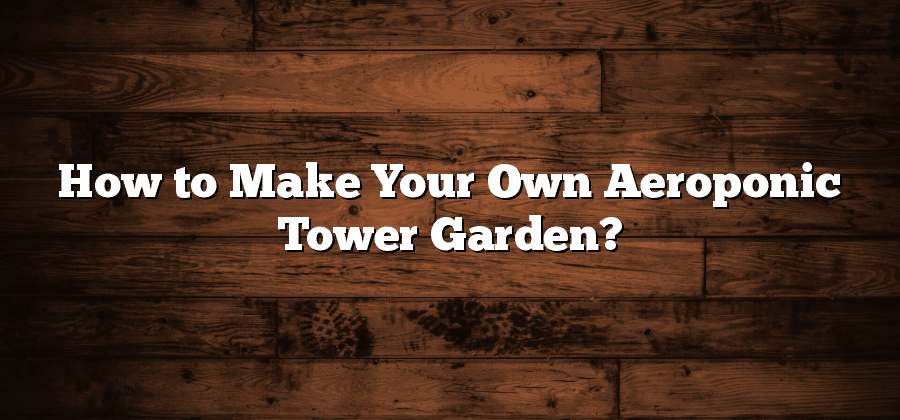Understanding the Basics of Aeroponic Tower Gardens
Aeroponic tower gardens are an innovative and efficient way to grow plants without the need for soil. Instead, these systems utilize a nutrient-rich mist that is sprayed directly onto the plant’s roots. This method of gardening has gained popularity in recent years due to its numerous advantages.
One of the main benefits of aeroponic tower gardens is their space-saving design. With vertical towers, plants can be grown in a compact area, making them ideal for urban environments or small outdoor spaces. Additionally, this method allows for a higher yield compared to traditional gardening methods. The nutrient-rich mist provides plants with the necessary components for growth, resulting in faster and healthier plant development. Moreover, aeroponic tower gardens use less water compared to traditional soil-based gardens, making them a more sustainable and eco-friendly option. Overall, by understanding the basics of aeroponic tower gardens, you can harness the power of this innovative gardening technique to grow a variety of plants in a small space effectively.
Selecting the Right Materials for Your Tower Garden
When it comes to selecting the right materials for your tower garden, it is essential to choose high-quality components that will ensure the success and longevity of your system. Primarily, you will need to consider the material for the tower frame itself. While various options are available, such as wood, PVC, or metal, it is important to choose a durable and weather-resistant material that can withstand the outdoor elements. Metal frames, like stainless steel or aluminum, are popular choices due to their strength and durability.
In addition to the frame, you will also need to select appropriate containers for your tower garden. These containers should be sturdy, lightweight, and have good drainage capabilities. One option is to use food-grade plastic containers, ensuring they are safe for growing edibles. Another alternative is using recycled materials, such as PVC pipes cut into smaller sections or repurposed buckets with drainage holes. Whatever material you choose, ensure that it is safe for your plants and fits well within the design of your tower garden.
Designing and Building the Frame for Your Tower Garden
The frame of your aeroponic tower garden is a crucial element in its overall stability and functionality. When designing and building the frame, it is important to consider the materials you will be using and their durability. You want to ensure that your tower garden is able to withstand various weather conditions and the weight of the plants and water.
When selecting the materials for your frame, opt for sturdy options such as PVC pipes or metal rods. These materials are known for their strength and longevity, making them ideal for supporting the weight of the tower garden. Additionally, consider the size and height of your tower garden when designing the frame. You want to ensure that it is able to accommodate the number of plant slots you desire and is tall enough to allow the plants to reach their full potential. By taking the time to carefully design and build the frame for your tower garden, you are setting yourself up for a successful and thriving aeroponic system.
Setting Up the Water Pump and Nutrient Delivery System
When setting up a water pump and nutrient delivery system for your aeroponic tower garden, it is crucial to ensure a proper and efficient installation. Firstly, select a high-quality water pump that is suitable for your tower garden’s size and water requirements. Consider factors such as flow rate, pressure, and energy efficiency when making your choice.
Once you have your water pump, it is essential to position it correctly in your tower garden. Place the pump at the bottom of the tower, ensuring that it is submerged in the nutrient-rich water solution. Proper positioning of the pump will allow it to efficiently circulate the water and nutrients to the plants, aiding in their growth and development. After the pump is in place, connect the water tubing and fittings, making sure they are securely attached to prevent any leaks or disruptions in the nutrient delivery system. Remember to regularly check and maintain the water pump and tubing to ensure optimal performance.
Choosing the Ideal Plants for Your Aeroponic Tower Garden
When it comes to choosing the ideal plants for your aeroponic tower garden, there are several factors to consider. First and foremost, it is important to select plants that are well-suited for vertical gardening and can thrive in a soilless environment. Some popular options include leafy greens such as lettuce, kale, and spinach, as well as herbs like basil, cilantro, and parsley.
Another factor to consider is the size of the plants. Since aeroponic tower gardens utilize vertical space efficiently, it is essential to choose plants that won’t outgrow the tower or overshadow neighboring plants. Compact varieties or those that can be easily trained to grow vertically are recommended.
Furthermore, consider the time it takes for each plant to reach maturity. Some plants, like leafy greens, have a relatively short cultivation cycle and can be harvested within a few weeks. On the other hand, fruits and vegetables like tomatoes or peppers may take longer to mature. It’s important to have a mix of plants with different growth rates to ensure a continuous and abundant harvest.






